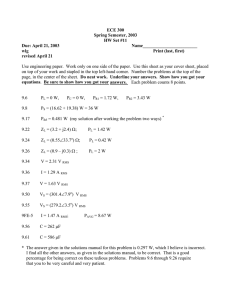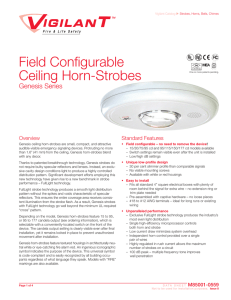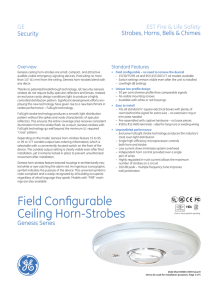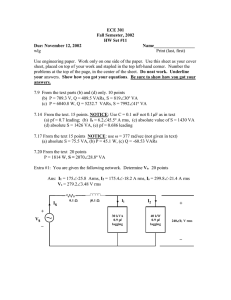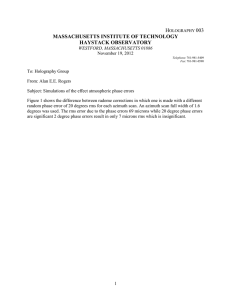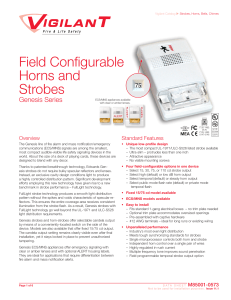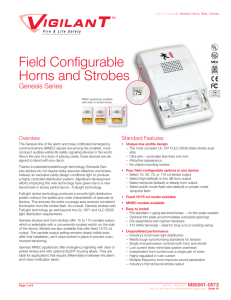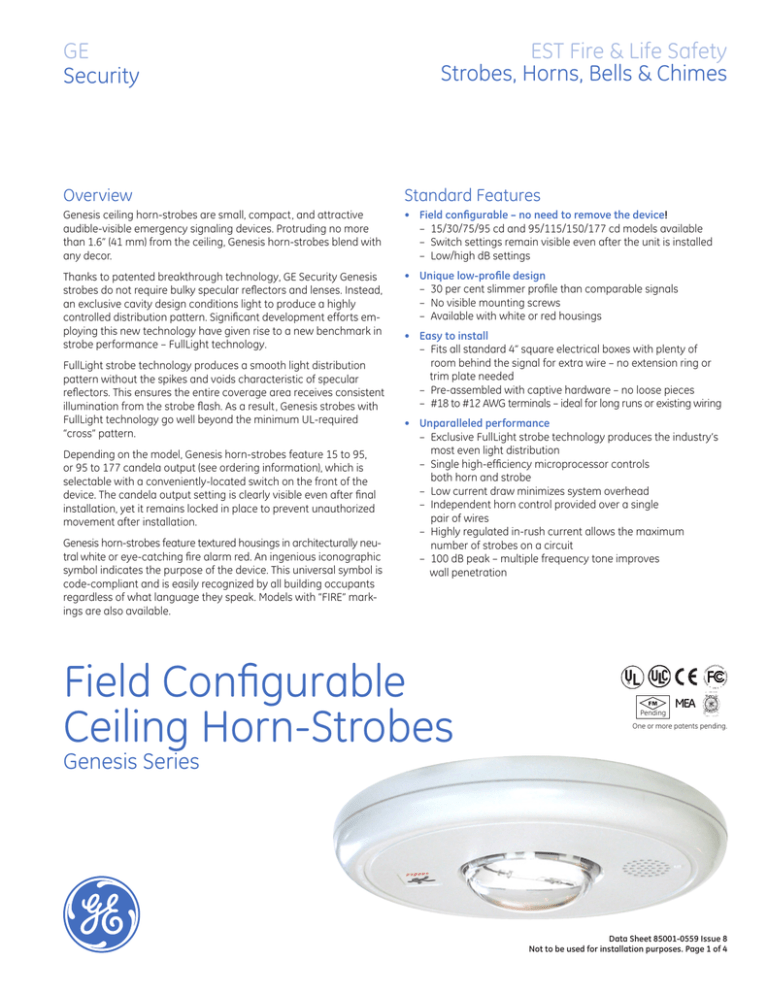
GE
Security
EST Fire & Life Safety
Strobes, Horns, Bells & Chimes
Overview
Standard Features
Genesis ceiling horn-strobes are small, compact, and attractive
audible-visible emergency signaling devices. Protruding no more
than 1.6” (41 mm) from the ceiling, Genesis horn-strobes blend with
any decor.
• Field configurable – no need to remove the device!
– 15/30/75/95 cd and 95/115/150/177 cd models available
– Switch settings remain visible even after the unit is installed
– Low/high dB settings
Thanks to patented breakthrough technology, GE Security Genesis
strobes do not require bulky specular reflectors and lenses. Instead,
an exclusive cavity design conditions light to produce a highly
controlled distribution pattern. Significant development efforts employing this new technology have given rise to a new benchmark in
strobe performance – FullLight technology.
• Unique low-profile design
– 30 per cent slimmer profile than comparable signals
– No visible mounting screws
– Available with white or red housings
FullLight strobe technology produces a smooth light distribution
pattern without the spikes and voids characteristic of specular
reflectors. This ensures the entire coverage area receives consistent
illumination from the strobe flash. As a result, Genesis strobes with
FullLight technology go well beyond the minimum UL-required
“cross” pattern.
Depending on the model, Genesis horn-strobes feature 15 to 95,
or 95 to 177 candela output (see ordering information), which is
selectable with a conveniently-located switch on the front of the
device. The candela output setting is clearly visible even after final
installation, yet it remains locked in place to prevent unauthorized
movement after installation.
Genesis horn-strobes feature textured housings in architecturally neutral white or eye-catching fire alarm red. An ingenious iconographic
symbol indicates the purpose of the device. This universal symbol is
code-compliant and is easily recognized by all building occupants
regardless of what language they speak. Models with “FIRE” markings are also available.
• Easy to install
– Fits all standard 4” square electrical boxes with plenty of
room behind the signal for extra wire – no extension ring or
trim plate needed
– Pre-assembled with captive hardware – no loose pieces
– #18 to #12 AWG terminals – ideal for long runs or existing wiring
• Unparalleled performance
– Exclusive FullLight strobe technology produces the industry’s
most even light distribution
– Single high-efficiency microprocessor controls
both horn and strobe
– Low current draw minimizes system overhead
– Independent horn control provided over a single
pair of wires
– Highly regulated in-rush current allows the maximum
number of strobes on a circuit
– 100 dB peak – multiple frequency tone improves
wall penetration
Field Configurable
Ceiling Horn-Strobes
Pending
MEA
One or more patents pending.
Genesis Series
Data Sheet 85001-0559 Issue 8
Not to be used for installation purposes. Page of 4
Application
Installation and Mounting
Genesis strobes are UL 1971-listed for use indoors as ceilingmounted public-mode notification appliances for the hearing impaired. Prevailing codes require strobes to be used where ambient
noise conditions exceed 105 dBA (87dBA in Canada), where occupants use hearing protection, and in areas of public accommodation as defined in the Americans with Disabilities Act (see application
notes – USA).
All models are intended for indoor wall or ceiling applications only.
Horn-strobes mount to any flush North-American 4” square electrical box.
Combination horn-strobe signals must be installed in accordance
with guidelines established for strobe devices.
Strobes
Genesis strobes are UL 1971-listed for use indoors as wall-mounted
public-mode notification appliances for the hearing impaired. Prevailing codes require strobes to be used where ambient noise conditions
exceed specified levels, where occupants use hearing protection,
and in areas of public accommodation. Consult with your Authority
Having Jurisdiction for details.
All Genesis strobes exceed UL synchronization requirements (within
10 milliseconds other over a two-hour period) when used with a
synchronization source. Synchronization is important in order to
avoid epileptic sensitivity.
NOTE: The flash intensity of some visible signals may not be adequate
to alert or waken occupants in the protected area. Research indicates
that the intensity of strobe needed to awaken 90% of sleeping persons is
approximately 100 cd. GE Security recommends that strobes in sleeping
rooms be rated at at least 110 cd.
WARNING: These devices will not operate without electrical power. As fires
frequently cause power interruptions, further safeguards such as backup
power supplies may be required.
Horns
Genesis horn output reaches as high as 99 dB (peak) and features
a unique multiple frequency tone that results in excellent wall
penetration and an unmistakable warning of danger. All models
may be configured for either coded or non-coded signal circuits.
They can also be set for low dB output with a jumper cut that
reduces horn output by about 5 dB.
The suggested sound pressure level for each signaling zone used with
alert or alarm signals is at least 15 dB above the average ambient sound
level, or 5 dB above the maximum sound level having a duration of at
least 60 seconds, whichever is greater, measured 5 feet (1.5 m) above the
floor. The average ambient sound level is, A-weighted sound pressure
measured over a 24-hour period.
Doubling the distance from the signal to the ear will theoretically
result in a 6 dB reduction of the received sound pressure level. The
actual effect depends on the acoustic properties of materials in the
space. A 3 dBA difference represents a barely noticeable change in
volume.
Genesis ceiling horn-strobes simply unlatch and twist to open.
This gains access to mounting screws and the selectable candela
switch. The shallow depth of Genesis devices leaves ample room
behind the signal for extra wiring. Once installed with the cover in
place, no mounting screws are visible.
GE Security recommends that these fire alarm horn-strobes always
be installed in accordance with the latest recognized edition of
national and local fire alarm codes.
Field Configuration
Depending on the model, Genesis horn-strobes may be set for 15
to 95, or 95 to 177 candela output (see ordering information). The
output setting is changed by simply opening the device and sliding
the switch to the desired setting. The horn-strobe does not have
to be removed to change the output setting. The setting remains
visible through a small window on the front of the device after the
cover is closed.
The horn-strobe comes factory set for high dB output. Low dB output may be selected by cutting a jumper on the circuit board. This
reduces the output by about 5 dB.
Wiring
Field wiring terminals accommodate #18 to #12 AWG (0.75 mm² to
2.5 mm²) wiring. Horn/strobes are interconnected with a single pair
of wires as shown below.
+
+
Polarity shown in
alarm condition
+
H
H
-
-
To next device
or end of line
device
Note: Strobes must have continuous voltage.
Dimensions
6.8" dia.
(173 mm)
1.0"
(25 mm)
0.60"(15 mm)
Data Sheet 85001-0559 Issue 8
Not to be used for installation purposes. Page of 4
Current Draw
GC-HDVM Temporal Horn-strobe: High dB Setting
15 cd
30 cd
75 cd
UL
Rating
RMS
RMS
RMS
16 Vdc
147
190
316
16 Vfwr
189
253
417
GC-HDVMH High cd Temporal Horn-strobe: High dB Setting
95 cd
115 cd
150 cd
177 cd
RMS
RMS
RMS
RMS
341
399
506
570
487
578
670
711
95 cd
RMS
372
451
GC-HDVM Temporal Horn-strobe: High dB Setting
15 cd
30 cd
75 cd
Typical
Current
RMS Mean RMS Mean RMS Mean
16 Vdc
111
95
152
143
281
276
20 Vdc
91
80
124
117
219
214
24 Vdc
80
71
108
101
185
180
33 Vdc
69
62
89
84
144
140
16 Vfwr
153
81
218
123
388
240
20 Vfwr
141
70
190
100
325
188
24 Vfwr
135
64
176
90
280
154
33 Vfwr
139
61
167
80
241
122
95 cd
RMS Mean
333
328
257
251
212
207
160
156
420
268
378
219
310
180
254
133
GC-HDVMH High cd Temporal Horn-strobe: High dB Setting
95 cd
115 cd
150 cd
177 cd
RMS Mean RMS Mean RMS Mean RMS Mean
324
322
377
374
477
474
554
551
258
256
299
296
369
366
417
414
220
217
252
249
304
301
341
338
172
169
188
185
223
220
244
241
463
265
535
312
665
400
718
442
392
211
439
240
517
287
587
334
346
179
382
212
458
246
498
271
296
142
323
152
358
178
387
194
GC-HDVM Temporal Horn-strobe: Low dB Setting
15 cd
30 cd
75 cd
Typical
Current
RMS Mean RMS Mean RMS Mean
16 Vdc
108
91
149
139
275
269
20 Vdc
87
75
120
113
214
209
24 Vdc
76
66
103
97
180
175
33 Vdc
64
57
85
80
138
135
16 Vfwr
141
76
204
118
384
239
20 Vfwr
127
65
176
95
312
181
24 Vfwr
118
60
162
82
262
149
33 Vfwr
127
56
155
73
229
118
95 cd
RMS Mean
327
322
250
245
205
201
153
150
418
265
371
214
301
171
249
129
GC-HDVMH High cd Temporal Horn-strobe: Low dB Setting
95 cd
115 cd
150 cd
177 cd
RMS Mean RMS Mean RMS Mean RMS Mean
317
315
378
376
480
477
544
542
252
250
292
290
364
362
414
411
212
211
245
243
297
295
334
332
159
157
181
179
215
213
234
232
461
265
521
305
656
396
705
432
381
208
437
242
508
285
576
326
335
172
370
195
440
235
485
264
285
134
308
149
349
169
373
186
Notes and Comments
1. Current values are shown in mA.
2. UL Nameplate Rating can vary from Typical Current due to measurement methods and instruments used.
3. GE Security recommends using the Typical Current for system design including NAC and Power Supply loading and voltage drop calculations.
4. Use the Vdc RMS current ratings for filtered power supply and battery AH calculations. Use the Vfwr RMS current ratings for unfiltered power supply calculations.
5. Fuses, circuit breakers and other overcurrent protection devices are typically rated for current in RMS values. Most of these devices operate based upon the heating affect of the
current flowing through the device. The RMS current (not the mean current) determines the heating affect and therefore, the trip and hold threshold for those devices.
6. Our industry has used ‘mean’ currents over the years. However, UL will direct the industry to use the 2004 RMS values in the future.
dBA output
High dB
Setting
16 Vdc
24 Vdc
33 Vdc
Light output - (effective cd)
UL464
Temporal
Steady
79.8
83.3
85
83.2
85.4
87.8
UL464
Low dB
Setting
Temporal
Steady
16 Vdc
24 Vdc
33 Vdc
75
78
80.9
79.3
83
85.9
Average
Temporal/
Steady
90.6
93.6
95.7
Peak
Temporal/
Steady
93.6
96.6
98.7
Average
Temporal/
Steady
86.3
88.8
91.8
Peak
Temporal/
Steady
88.7
92.4
95.1
Percent of UL rating versus angle
120 110 100 90
80
70
60
50
40
30
Per Cent of UL Rating
20 10 0 10 20
30
40
50
60
70
80
90 100 110 120
90°
75°
-75°
60°
-60°
45°
-45°
30°
-30°
-15°
0°
15°
Notes
1. All values shown are dBA measured at 10 feet (3.01m); 2. UL464 values measured in
reverberation room; 3. Average and Peak values are measured in anechoic chamber.
Data Sheet 85001-0559 Issue 8
Not to be used for installation purposes. Page of 4
GE
Security
U.S.
T 888-378-2329
F 866-503-3996
Specifications
Housing
Canada
T 519 376 2430
F 519 376 7258
Lens
Asia
T 852 2907 8108
F 852 2142 5063
Wire connections
Australia
T 61 3 9259 4700
F 61 3 9259 4799
Europe
T 32 2 725 11 20
F 32 2 721 86 13
Latin America
T 305 593 4301
F 305 593 4300
Mounting
Operating environment
Agency listings/approvals
Operating voltage
Strobe output rating
www.gesecurity.com/est
© 2007 General Electric Company
All Rights Reserved.
Strobe flash rate
Genesis Series is a trademark of GE Security.
Synchronization Sources
Horn pulse rate
Temporal audible pattern
Textured UV stabilized, color impregnated engineered plastic. Exceeds 94V-0
UL flammability rating. Red and white models available.
Optical grade polycarbonate (clear)
North-American 4” square box, 2 1/8” (54 mm) deep (indoor wall or
ceiling applications only).
Screw terminals: single input for both horn and strobe. #18 to #12 AWG
(0.75 mm² to 2.5 mm²) wire size
Indoor: 32-120°F (0-49°C) ambient temperature. 93% relative humidity
Meets or exceeds ULC-S541, year 2004 UL requirements for standards
UL1638 and UL1971, and complies with UL1480. All horn-strobes
comply with ADA Code of Federal Regulation Chapter 28 Part 36 Final
Rule. CSFM, MEA. FM pending.
GC-HDVM series temporal-tone horn-strobes: non-coded, filtered 16-33
Vdc or unfiltered 16-33 Vdc FWR (or coded (audible NAC only) when
used with optional G1M Genesis Signal Master)
UL 1971, UL 1638, ULC S526: selectable 15/30/75/95 cd (GC-HDVM) and
95/115/150/177 cd (GC-HDVMH)
GC-HDVM series temporal-tone horn-strobes: one flash per second
synchronized with optional G1M Genesis Signal Master indefinitely
within 10 milliseconds (or self-synchronized within 200 milliseconds over
thirty minutes on a common circuit without G1M Genesis Signal Master)
Temporal setting (private mode only): synchronized to temporal output of
horns on same circuit
G1M-RM, SIGA-CC1S, SIGA-MCC1S, BPS6A, BPS10A
GC-HDVM series temporal-tone horn-strobes: temporal rate
synchronized with optional G1M Genesis Signal Master indefinitely
within 10 milliseconds (or self-synchronized within 200 milliseconds over
thirty minutes on a common circuit without G1M Genesis Signal Master)
½ sec ON, ½ sec OFF, ½ sec ON, ½ sec OFF, ½ sec ON, 1½ sec OFF, then
repeat cycle
Ordering Information
Catalog
Number
GC-HDVM
GCF-HDVM
GCFR-HDVM
GC-HDVMH
GCF-HDVMH
Housing
Color
White
White
Red
White
White
Accessories
G1M-RM
SIGA-CC1S
SIGA-MCC1S
Genesis Signal Master – Remote Mount (1-gang)
Intelligent Synchronization Output Module (2-gang)
Intelligent Synchronization Output Module (Plug-in UIO)
Marking
None
“FIRE”
“FIRE”
None
“FIRE”
Ship Wt.
lbs (kg)
Description
Genesis Ceiling/Wall Horn-Strobe
with selectable 15, 30, 75, or 95 cd output
0.82 (1.8)
Genesis Ceiling/Wall Horn-Strobe
with selectable 95, 115, 150, or 177 cd output
0.2 (0.1)
0.5 (0.23)
0.18 (0.08)
White Field Configurable Ceiling Horn-Strobes may be
ordered with or without optional ‘FIRE’ marking. Red
Horn-Strobes come with ‘FIRE” marking.
Data Sheet 85001-0559 Issue 8
Not to be used for installation purposes. Page of 4

